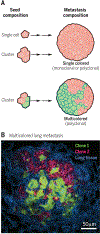A collective route to metastasis: Seeding by tumor cell clusters
- PMID: 27124449
- PMCID: PMC8183671
- DOI: 10.1126/science.aaf6546
A collective route to metastasis: Seeding by tumor cell clusters
Abstract
Despite decades of study, there are still many unanswered questions about metastasis, the process by which a localized cancer becomes a systemic disease. One of these questions is the nature of the tumor cells that give rise to metastases. Although conventional models suggest that metastases are seeded by single cells from the primary tumor, there is growing evidence that seeding requires the collective action of tumor cells traveling together in clusters. Here, we review this evidence, which comes from analysis of both experimental models and patient samples. We present a model of metastatic dissemination that highlights the activities of clusters of tumor cells that retain and require their epithelial properties.
Copyright © 2016, American Association for the Advancement of Science.
Figures


References
Publication types
MeSH terms
Grants and funding
LinkOut - more resources
Full Text Sources
Other Literature Sources

